Lighting really sets the vibe in your home, doesn’t it? It’s more than just picking out nice fixtures—it’s about shaping spaces that fit your life and mood. The right lighting can turn any room from basic to welcoming, productive, and honestly, just way more beautiful.
Remember to repin your favorite images!
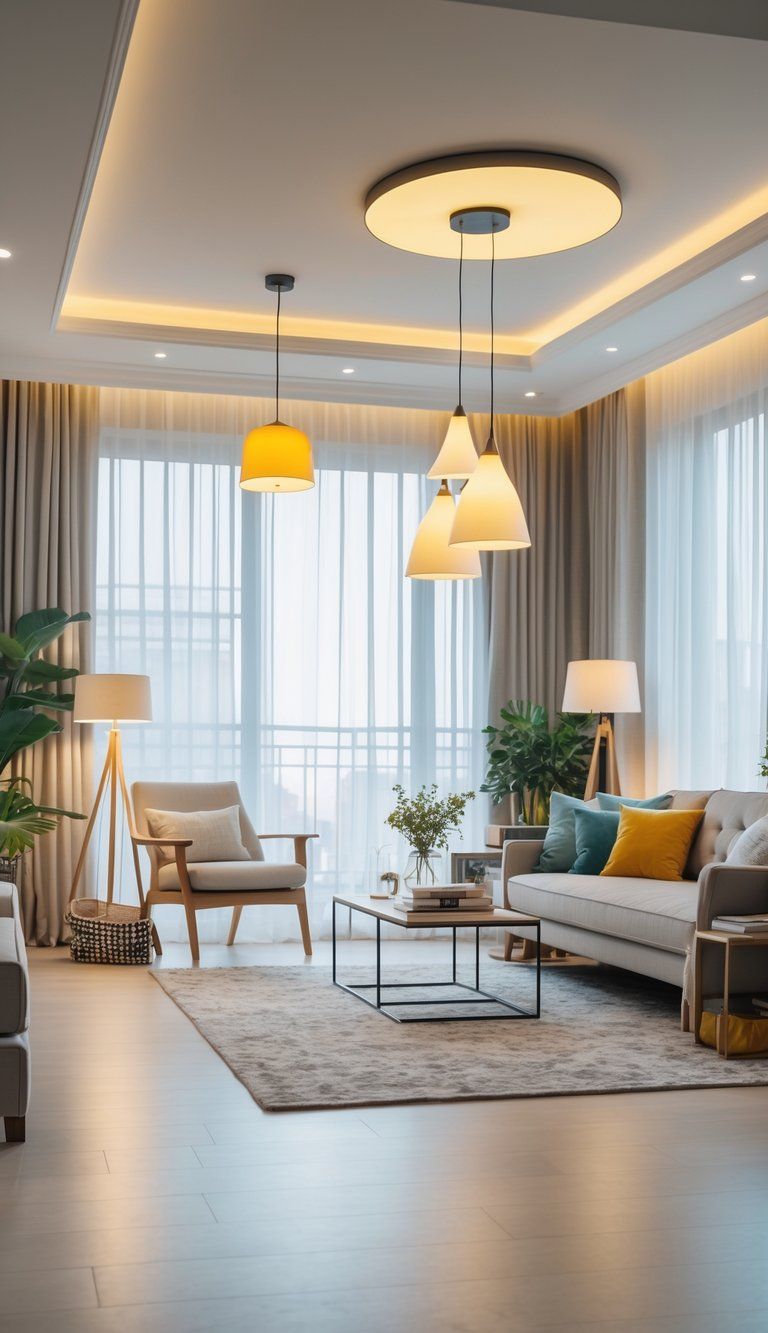
Good lighting design brings together three essentials: general lighting that lights up the whole room, task lighting for specific activities, and accent lighting to highlight features you love. When you blend these, rooms feel more functional and look better too. Every room needs its own lighting setup, depending on what you do there.
If you take the time to plan your lighting, you’ll notice the difference every day. Whether you’re making dinner, reading, or having friends over, the right lighting makes everything easier and more enjoyable.
There are so many options now—classic fixtures, smart bulbs, you name it. You can tailor your lighting to fit your routine and boost your home’s style.
Lighting Fundamentals: Understanding the Basics
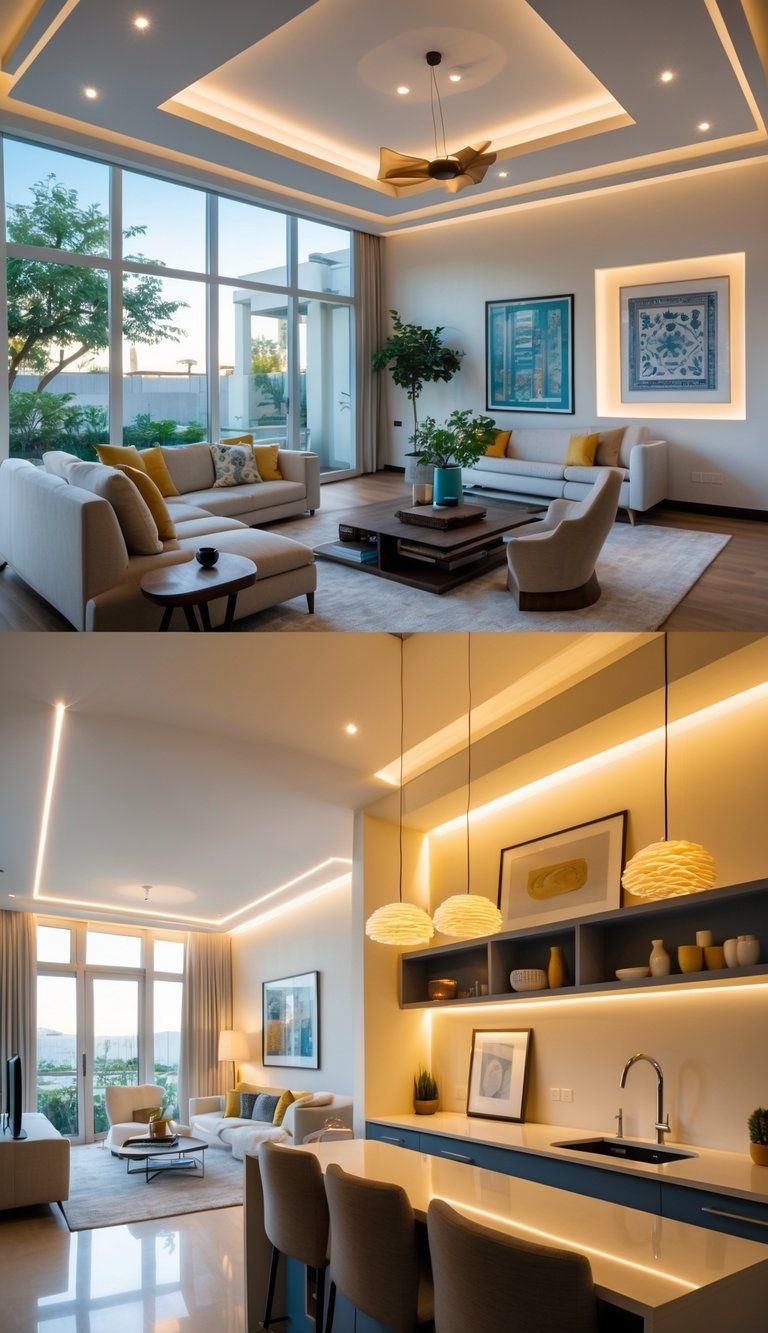
Lighting changes a house into a home. If you understand the different types and how to layer them, you’ll have way more control over your space.
Types of Lighting Explained
Lighting usually falls into three main types, and each one does something different:
Ambient (General) Lighting: This one’s your main light source. It sets the base level of brightness and comes from ceiling fixtures, recessed lights, or even big windows. Good ambient lighting fills the room evenly and avoids harsh shadows.
Task Lighting: This is focused light for getting things done. Think:
- Reading lamps by beds or couches
- Under-cabinet lights in the kitchen
- Desk lamps in your office
- Vanity lights in the bathroom
Accent Lighting: This type draws your eye to something special. Use it for art, cool architecture, or anything you want to show off. Wall sconces, track lights, and adjustable recessed fixtures all work here.
Lighting Layers for Each Space
Layering your lighting adds depth and flexibility. Most well-designed rooms use all three types.
Start with ambient lighting as your base. This sets the main brightness.
Add task lighting where you need extra light for activities.
Finish with accent lighting to highlight features you love. This setup lets you tweak the mood as the day goes on.
What works best depends on the room. Kitchens need strong task lighting, while living rooms usually feel best with more ambient and accent options.
Lighting Fixtures and Bulb Types
Picking the right fixtures and bulbs can totally change how your lighting feels.
Common Fixture Types:
- Pendant lights (awesome over dining tables and kitchen islands)
- Chandeliers (bring drama to entryways or dining rooms)
- Recessed lights (clean and subtle for ambient light)
- Wall sconces (great in hallways and bathrooms)
- Floor and table lamps (super flexible for living spaces)
Bulb Options:
- LED: Saves energy, lasts long, comes in lots of colors
- CFL: Better than incandescent, not as efficient as LED
- Halogen: Bright and white, but uses more energy
- Incandescent: Classic warm glow, but not energy-friendly
Bulb color temperature—measured in Kelvins (K)—shapes the mood. Lower (2700-3000K) feels cozy and warm, while higher (4000-5000K) gives off a brighter, cooler vibe.
Room-by-Room Lighting Strategies
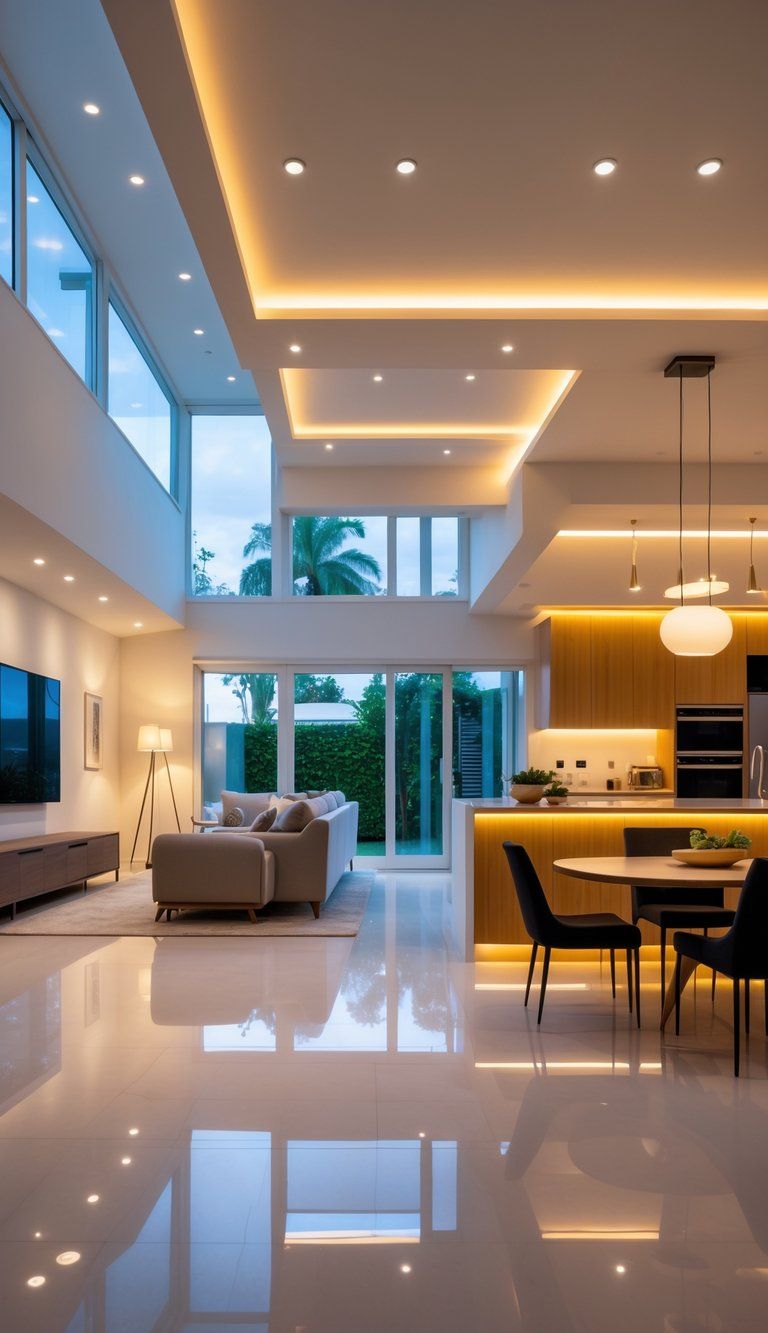
Every room has its own job, so you’ll want to match the lighting to what you actually do there. The right setup can turn any space from just okay to seriously impressive.
Living Room Lighting Design
Your living room needs versatile lighting to keep up with everything you do. Start with ambient light—maybe a ceiling fixture or recessed lights. Add table or floor lamps around seating for reading or working.
Try these ideas:
- Layer your lighting: Mix overhead lights, wall sconces, and lamps
- Dimmer switches: Super useful for setting the mood any time
- Warm bulbs: Stick to 2700K-3000K for a cozy feel
Accent lighting works wonders for artwork or cool architecture. Wall washers or picture lights really make things pop.
If your living room doesn’t get much sunlight, add more ambient light and pick fixtures that bounce light up to open up the space.
Kitchen Lighting Solutions
The kitchen is all about practical, bright lighting so you can prep and cook safely. Layering is key here.
Must-haves:
- Overhead lights: Recessed or flush-mount for general brightness
- Task lighting: Under-cabinet LEDs to get rid of counter shadows
- Island/dining: Pendant lights about 30-36 inches above surfaces
For bigger kitchens, set up zones with their own controls. That way, you only light up the parts you’re using.
Choose cooler bulbs (3500K-4000K) in work zones for clear visibility. For eating areas, warmer bulbs help everyone relax.
Toe-kick lighting under cabinets is a nice touch for gentle night light—no harshness needed.
Bedroom Lighting Ideas
Bedroom lighting should help you unwind but still be bright enough for what you need. It’s all about balance.
Start with soft ambient light from a ceiling fixture, and if you can, put it on a dimmer. Add bedside lamps or wall-mounted reading lights at a height that lets you read without bothering anyone else.
Smart bedroom lighting:
- Mix it up: Use ceiling lights, bedside lamps, and maybe a little accent lighting
- Stick to warm bulbs: 2700K-3000K helps you relax and sleep better
- Convenient controls: Put switches near the bed
Soft lights in closets and dressing areas are super helpful. Full-spectrum bulbs in these spots let you see your clothes’ true colors.
If you do yoga or exercise in your bedroom, make sure you’ve got brighter lights handy for those times.
Bathroom and Dining Room Lighting Guide
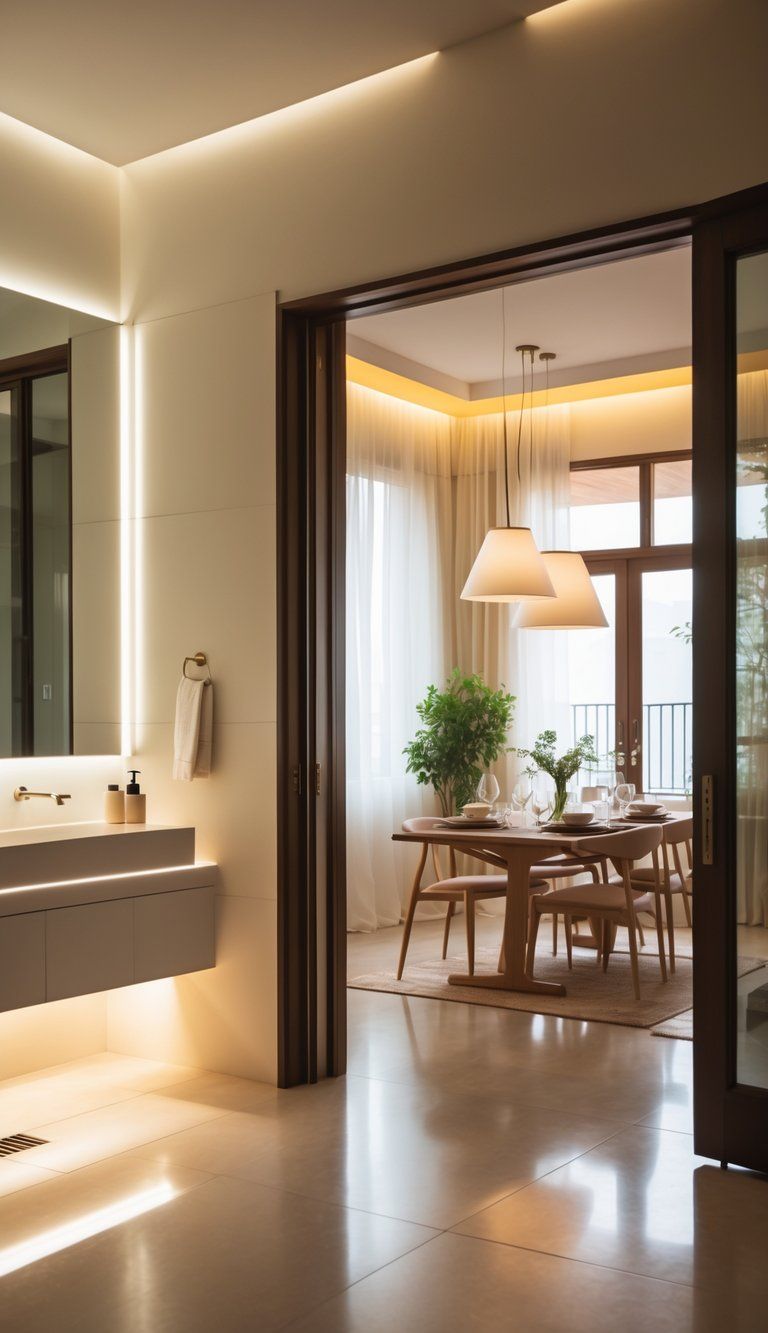
Bathrooms and dining rooms need lighting that’s both practical and atmospheric. Each space calls for its own approach.
Bathroom Lighting Approaches
Bathrooms need layers to prevent shadows and give you enough brightness for things like shaving or makeup. Start with overhead lights—aim for about 70-80 lumens per square foot.
For mirrors, put sconces at eye level on both sides instead of above. This setup avoids those weird, unflattering shadows. Try fixtures in the 2700K-3000K range for a warm, flattering look.
Some bathroom lighting ideas:
- Vanity sconces: Mount at eye level, spaced 36-40 inches apart
- Recessed lights: Place over showers or tubs
- Decorative fixtures: Add style and a little more ambient light
Always use waterproof fixtures in showers—look for at least IP44 for splash protection.
Dining Room Lighting Plan
The dining room light should steal the show and set the mood for meals. A chandelier or pendant above the table feels welcoming and special.
When picking fixture size, add your room’s length and width in feet, then use that number in inches for the fixture diameter. So, a 10′ × 12′ room needs a 22″ fixture.
Hang your main light 30-36 inches above the table if you’ve got an 8-foot ceiling. For every extra foot of ceiling, add 3 inches to the hanging height.
Try these in your dining room:
- Central pendant or chandelier: Makes the room pop
- Dimmer switches: Adjust from bright to intimate in seconds
- Warm bulbs: 2700K-3000K for a cozy, appetizing glow
Aim for 3,000-6,000 lumens total, depending on room size and how much daylight you get.
Specialized Lighting: Home Office, Entryway, and More
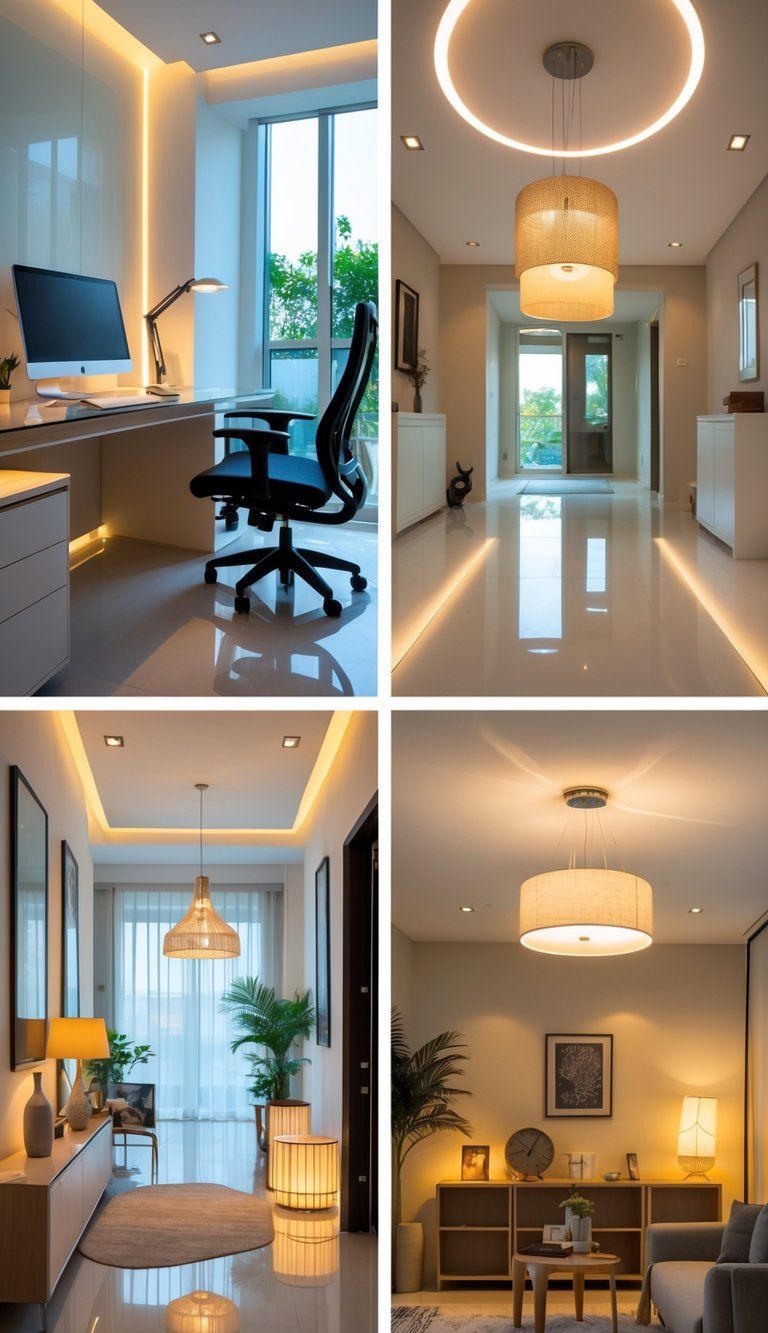
Some spaces—like home offices or entryways—deserve a little extra thought when it comes to lighting. Getting it right can make these areas more useful and welcoming.
Effective Home Office Lighting
Your home office needs lighting that keeps your eyes happy and your brain alert. Start with a ceiling fixture for even light.
Task lighting is a must. Put a desk lamp where it lights your work but doesn’t glare on your screen. Adjustable arms and brightness controls let you tweak things as you go.
Try to keep your computer out of direct window glare. Natural light is great, but try to set your desk perpendicular to windows if you can.
For video calls, add a small lamp that lights your face gently. This gets rid of harsh shadows and helps you look your best.
Pick bulbs in the 3500-5000K range for office spaces—they’re bright enough to keep you focused but not so harsh they mess with your sleep.
Entryway Lighting Tips
Your entryway is the first thing people see, so make it shine. A statement pendant or chandelier instantly sets the mood.
Make sure the entryway is bright enough for safety—shoot for a 75-100 watt equivalent in your main fixture.
For big foyers, layer up:
- Ceiling light for the basics
- Wall sconces at eye level to add some character
- Table lamp on a console for a cozy touch
Keep switches easy to reach near the door. Dimmers let you change up the vibe depending on the time or occasion.
If there’s a closet, a motion-sensor light inside saves you from fumbling when your hands are full.
Hallway and Staircase Lighting
Hallways and stairs need enough light for safety, but that doesn’t mean they have to be boring. Recessed ceiling lights spaced 8-10 feet apart keep things bright without clutter.
Wall sconces add both light and a bit of style. Mount them at about 5.5-6 feet high and keep them 8-10 feet apart.
For stairs, make sure every step is visible. You can use recessed lights above or little LED fixtures right in the stairs.
Motion-activated lights are super handy here, especially at night. They save energy and only come on when you need them.
Hallways often connect different rooms, so pick a neutral color temperature (around 3000K) to help everything flow together.
Outdoor and Landscape Lighting Solutions
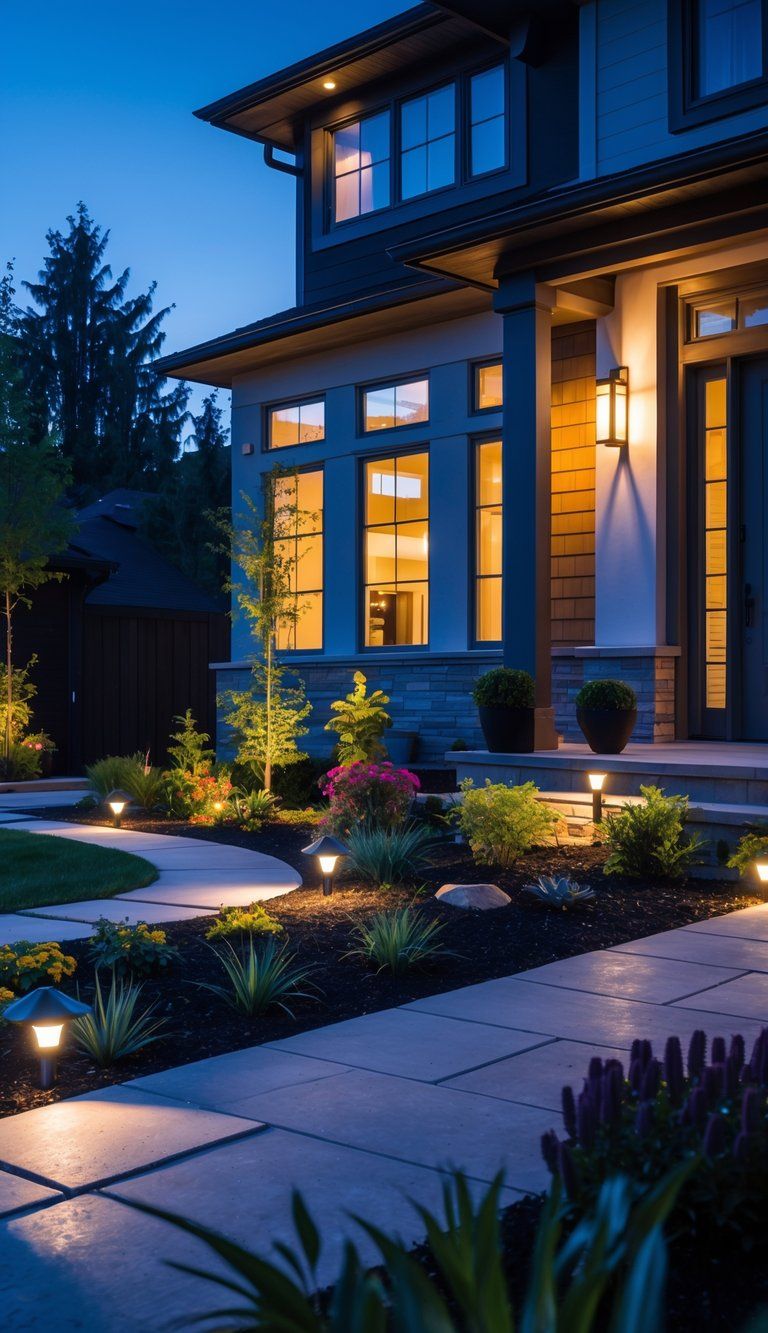
Outdoor lighting isn’t just about safety—it shows off your home’s best features. The right landscape lighting can really make your place stand out at night.
Outdoor Lighting Essentials
When you plan outdoor lighting, keep three things in mind: safety, security, and aesthetics.
Pathway lights help people avoid trips and falls by lighting up walkways and steps. Place them about 14 inches above the ground and keep them 8-10 feet apart for even coverage.
Entry lighting matters for safety and making guests feel welcome. Wall sconces or pendant lights on each side of your door work well. If security is on your mind, motion-sensor lights near garages and side entrances are a smart choice.
On decks and patios, think about how you actually use the space. Recessed lights are great for cooking areas. String lights bring that cozy, relaxed vibe when you’re entertaining.
Solar-powered lights save energy and make installation easier since you don’t need wiring.
For outdoor use, always pick weather-resistant fixtures with a good IP rating. Go for IP65 or higher if the area gets rain or moisture.
Landscape Lighting Techniques
Landscape lighting can really show off your property’s best features and set the mood.
Uplighting puts fixtures at ground level and aims light upward to highlight trees or cool architectural details. It adds drama and depth to your yard.
Downlighting mimics moonlight when you install it in trees or on structures. This creates soft, diffused light, which is perfect for patios and hangout spots.
Path lighting does double duty—it keeps you safe and defines the edges of your landscaping.
Try out these lighting methods:
- Silhouetting: Place lights behind objects for dramatic shadows.
- Grazing: Put lights close to textured surfaces to show off details.
- Moonlighting: Install lights high in trees, pointing down.
- Cross lighting: Use multiple lights to wipe out harsh shadows.
Many homes now use smart landscape lighting. You can control brightness, color, and timing right from your phone. Color-changing lights let you switch things up for different seasons or parties.
If this all sounds overwhelming, a good lighting pro can blend the technical stuff with design to get the best results.
Choosing Lighting Fixtures and Designs
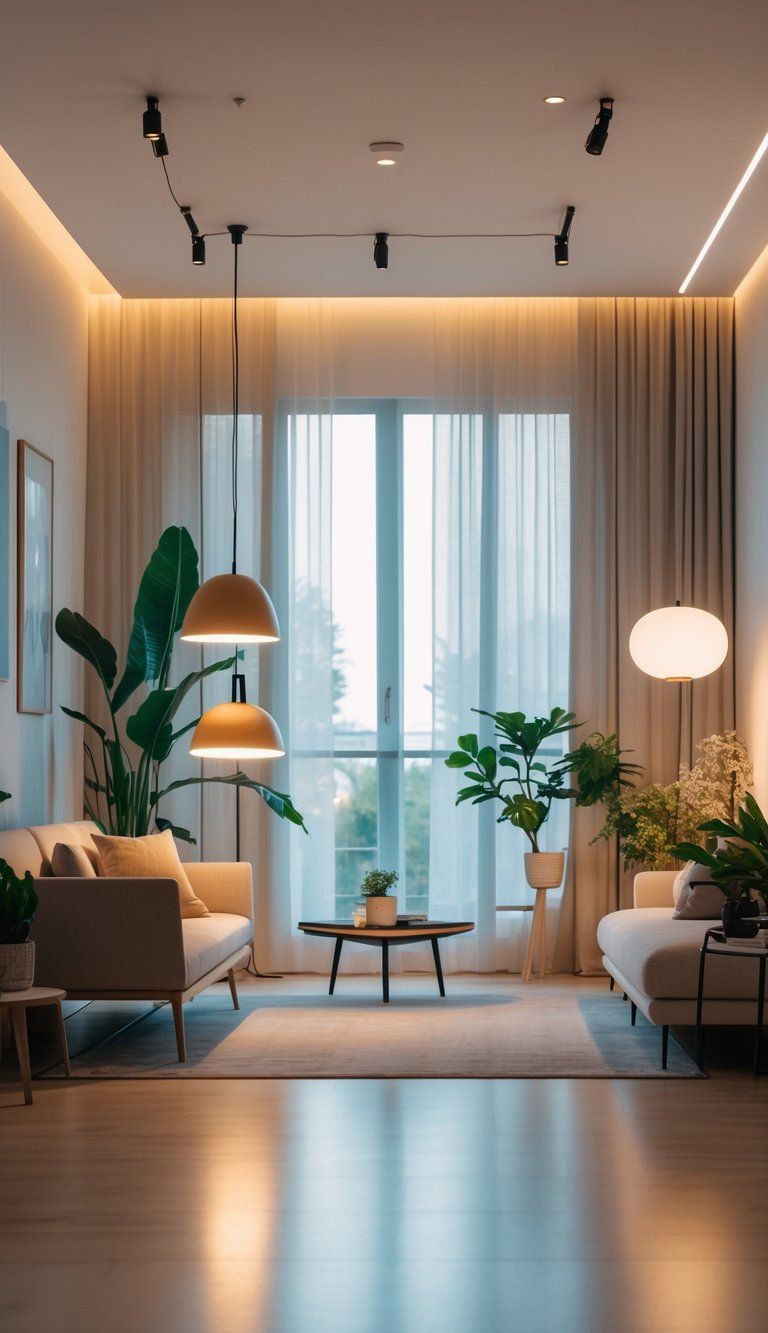
Picking the right fixtures makes a huge difference in both how your home works and how it feels. The best lighting choices mix practical light with style that matches your vibe.
Selecting the Right Fixtures for Each Room
Layered lighting just works in living rooms. Try a central ceiling light like a chandelier or semi-flush mount for overall glow. Wall sconces can chase away shadows and make the space feel warmer.
Kitchens need bright, focused light. Pendant lights look great over islands, and recessed lights spread brightness everywhere. Under-cabinet lights are a must for prepping food.
In bedrooms, soft and flattering lights feel best. A semi-flush mount or small chandelier handles general lighting, while bedside lamps or wall-mounted reading lights are perfect for reading at night.
Bathrooms call for bright, even light. Vanity lights or sconces on each side of the mirror help you avoid shadows on your face. A water-resistant ceiling fixture covers the rest of the room.
Dining rooms come alive with dramatic lighting. Hang chandeliers 30-34 inches above the table if your ceiling is 8 feet high.
Popular Fixture Styles and Applications
Modern fixtures keep things simple with clean lines and little fuss. They fit right in with sleek furniture and neutral colors.
Traditional fixtures lean classic, often with crystals or glass. They look right at home in formal dining rooms or classic décor.
Industrial fixtures show off exposed bulbs and metal finishes. They really pop in lofts or with exposed brick.
Farmhouse fixtures bring in natural materials like wood and iron. These make country kitchens and rustic living rooms feel cozy.
A few tips that actually help:
- Match fixture size to your room—big rooms need bigger lights.
- Try to match fixture finishes with your hardware.
- Dimmers give you options.
- Layer different lights for more depth.
Maximizing Natural and Artificial Light
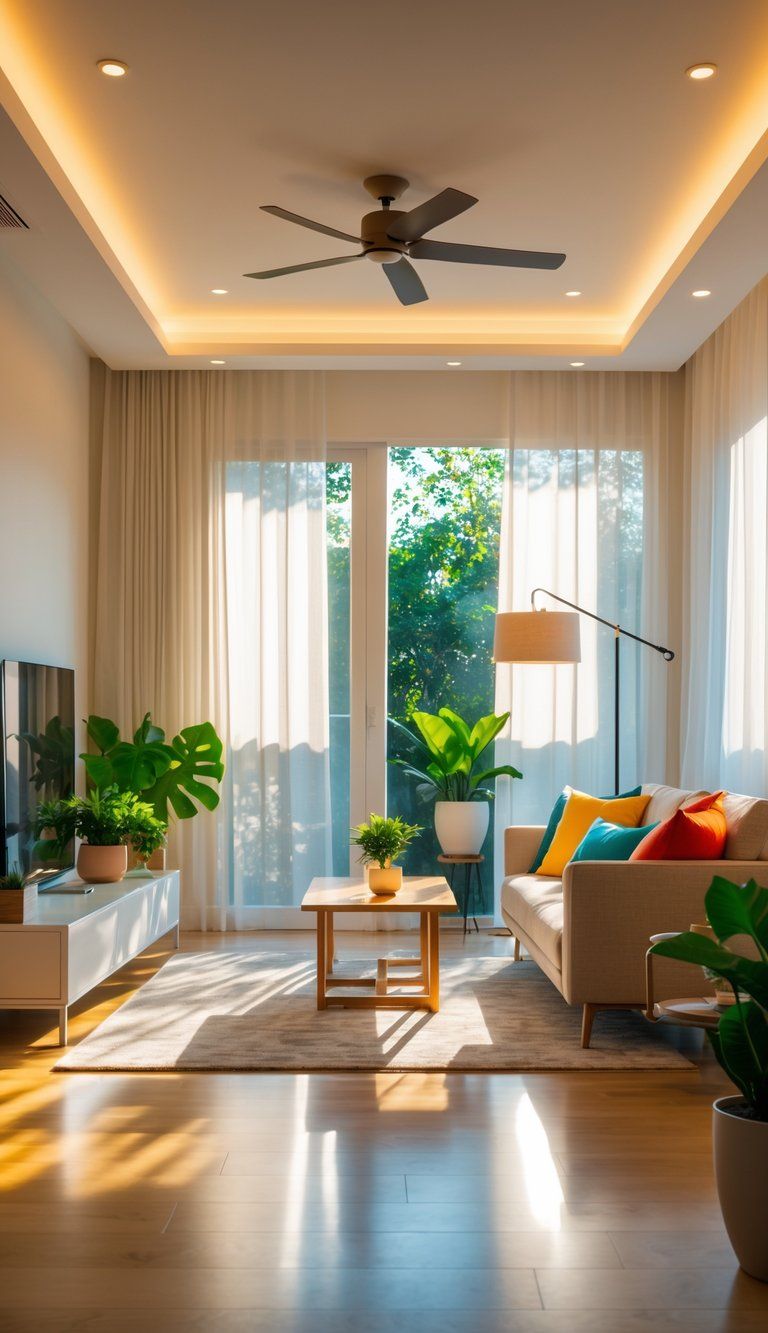
Light can totally change your home’s look and how you use each room. When you get the balance between natural and artificial light right, rooms feel bigger, more inviting, and just work better.
Incorporating Daylight into Your Home
Mirrors can seriously boost natural light. Put them across from windows to bounce sunlight into darker corners. Large mirrors even make rooms look bigger.
Keep your windows clean—dust and dirt can block up to 30% of the light. It’s worth cleaning them every few months for the brightest results.
Hang curtains high and wide. Mount rods 4-6 inches above the window and extend them 8-12 inches past the sides. This trick makes your windows look bigger and lets in more light.
Go for light wall colors like soft whites, creams, or pastels. These shades reflect light instead of soaking it up.
Glass doors can bring more sunshine into rooms that need it. French doors or sliding glass doors can really brighten up living rooms and kitchens.
Balancing Artificial and Natural Sources
Layering your lighting gives you options. Use a mix of ambient, task, and accent lighting to get just the right feel at any time of day.
Dimmers let you adjust the brightness as daylight changes. That way, you keep things comfortable and save energy too.
Pick the right color temperature for each space. Cooler lights (4000-5000K) fit kitchens and offices. Warmer lights (2700-3000K) make bedrooms and living rooms feel cozy.
Choose fixtures that work with your natural light. Pendant lights above kitchen islands or dining tables give you focused light without fighting sunlight.
Put table and floor lamps in the spots that don’t get much sun. This helps balance out the room and keeps every corner well-lit.
Setting the Mood and Aesthetic with Lighting
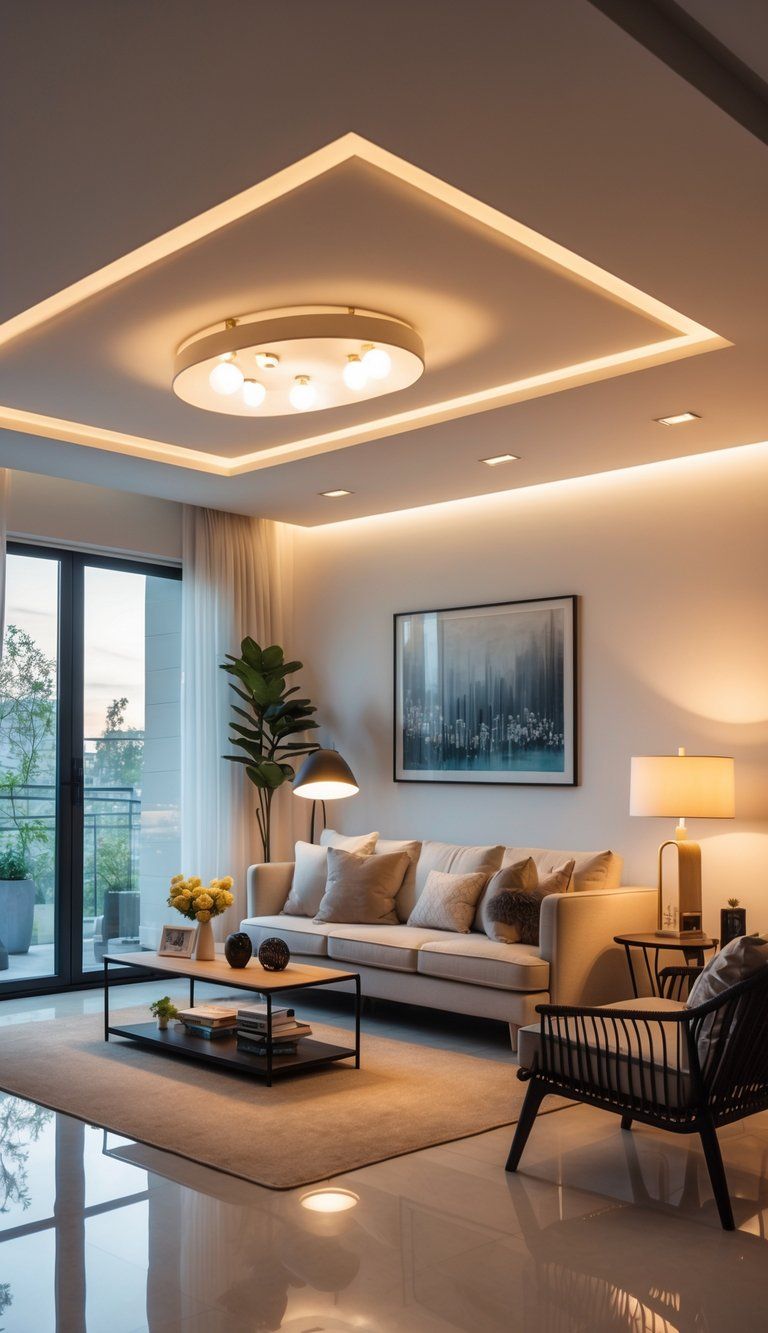
Lighting isn’t just about seeing in the dark—it shapes how you feel at home. The right lights can totally shift a room’s mood and show off your style.
Creating Atmosphere with Color Temperature
Color temperature (measured in Kelvins) can really set the tone. It’s interesting—over half of people say lighting affects their mood at home.
Warm light (2700-3000K) feels cozy and relaxing, which is perfect for living rooms and bedrooms. That yellowish glow is a lot like sunset, which helps you wind down.
Cool white light (3500-4500K) is great for kitchens or home offices where you need to focus. It looks more blue-white and feels like daylight.
Daylight bulbs (5000-6500K) are best for places like craft rooms or garages where you want to see colors clearly.
If you’re into tech, smart bulbs let you change color temperature throughout the day to match what you’re doing.
Enhancing Aesthetic Appeal with Lighting
Layering is everything. Combine these three:
- Ambient lighting: Ceiling fixtures or recessed lights for overall glow.
- Task lighting: Desk lamps or under-cabinet lights for focused jobs.
- Accent lighting: Track lights or wall sconces to highlight cool features or art.
Pick fixture styles that fit your space. Modern rooms look good with geometric shapes, while traditional rooms shine with classic designs and warm metals.
Use lighting to create focal points. A dramatic pendant over the dining table or a sconce next to artwork draws the eye in.
Shadows matter, too—they add depth. Uplight a plant for cool patterns, or use side lighting to bring out texture in brick or stone.
Functional Lighting Tips and Best Practices

Good lighting does more than just brighten a room. It makes spaces work for your daily life and helps every room feel comfortable, no matter the size or ceiling height.
Lighting for Functionality and Comfort
Mixing different light types is the secret to a functional space. Start with ambient light, then add task lighting where you need it.
In kitchens, under-cabinet lights get rid of shadows on countertops. For home offices, a well-placed desk lamp can cut eye strain and reduce screen glare.
Bathrooms need lights on both sides of the mirror so you don’t get unflattering shadows. Living rooms feel more flexible when you add dimmers, making it easy to switch from daytime to nighttime moods.
Use cooler lights (4000-5000K) in work zones and warmer lights (2700-3000K) where you relax.
Adapting Lighting to Room Size and Ceiling Height
Small rooms can feel bigger with the right lighting. Wall sconces and lights that shine upwards draw your eyes up and make the space feel more open.
For low ceilings (8 feet or less), skip hanging fixtures that drop more than 12 inches. Recessed lights are a safe bet—they light things up without making the ceiling feel lower.
High ceilings (10+ feet) need more powerful lighting to fill the space. Try:
- Multi-tiered chandeliers that use up vertical space
- Wall-mounted fixtures at eye level to bring light down
- Track lighting so you can aim light where you want
Here’s a quick formula: Multiply your room’s square footage by 1.5 to figure out how many watts you need. For example, a 200-square-foot room should have about 300 watts total, spread across different fixtures.
Smart, Efficient, and Sustainable Lighting Choices
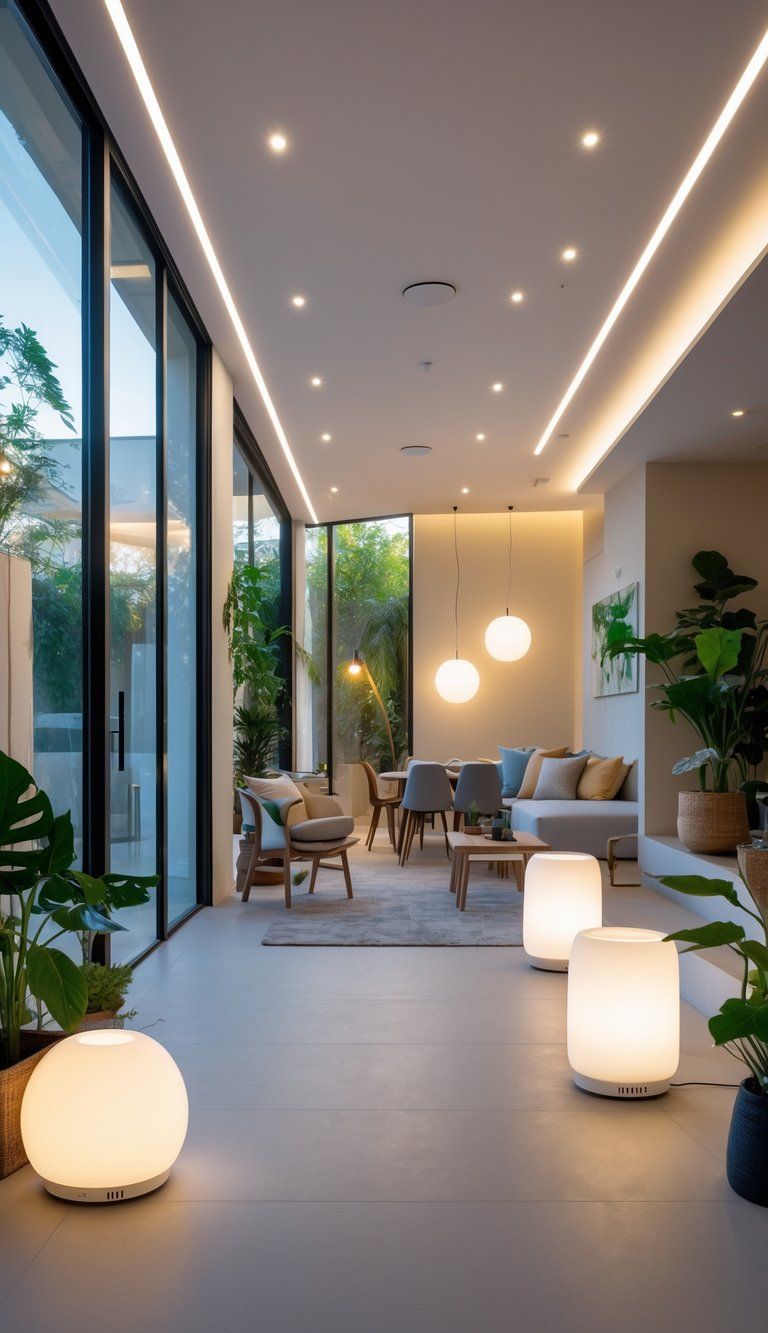
Modern lighting brings together style, function, and energy savings. With new technology and eco-friendly features, you can create comfy spaces that are also good for the planet.
Energy-Efficient Lighting Technologies
LED bulbs are the top choice these days. They use up to 75% less energy than old-school bulbs and last way longer—think 15,000 to 25,000 hours instead of just 1,000. That’s a lot of saved cash on your electric bill.
Fluorescent bulbs used to be the go-to, but LEDs have taken the lead. They’re more efficient, better for the environment, and don’t contain mercury.
When you’re shopping for efficient lights, keep an eye on:
- Lumens: More lumens means more brightness.
- Wattage: Lower wattage means less energy used.
- Color temperature: 2700K-3000K for warm, 3500K-4100K for neutral, 5000K-6500K for cool/daylight.
Solar-powered LED lights are catching on, especially outside. They charge during the day and light up your garden or walkway at night—no extra energy use needed.
Smart Controls and Automation
Smart lighting systems change the way you use lights at home. You can adjust brightness, color, and schedules from your phone or with your voice.
Motion sensors turn lights on when you walk in and off when you leave. That’s handy in hallways, bathrooms, and utility rooms.
With programmable schedules, you can set lights to follow your daily routine. Imagine your bedroom lights slowly brightening to wake you up gently.
Some advanced systems go even further:
- They learn your habits and adjust automatically.
- They sync with other smart home gadgets.
- You can set up custom scenes for movie nights or parties.
- Lights can dim gradually at night to help you wind down.
Most smart systems work with LED bulbs, so you get the best of both worlds—energy savings and convenience.
Building a Personalized Lighting Plan
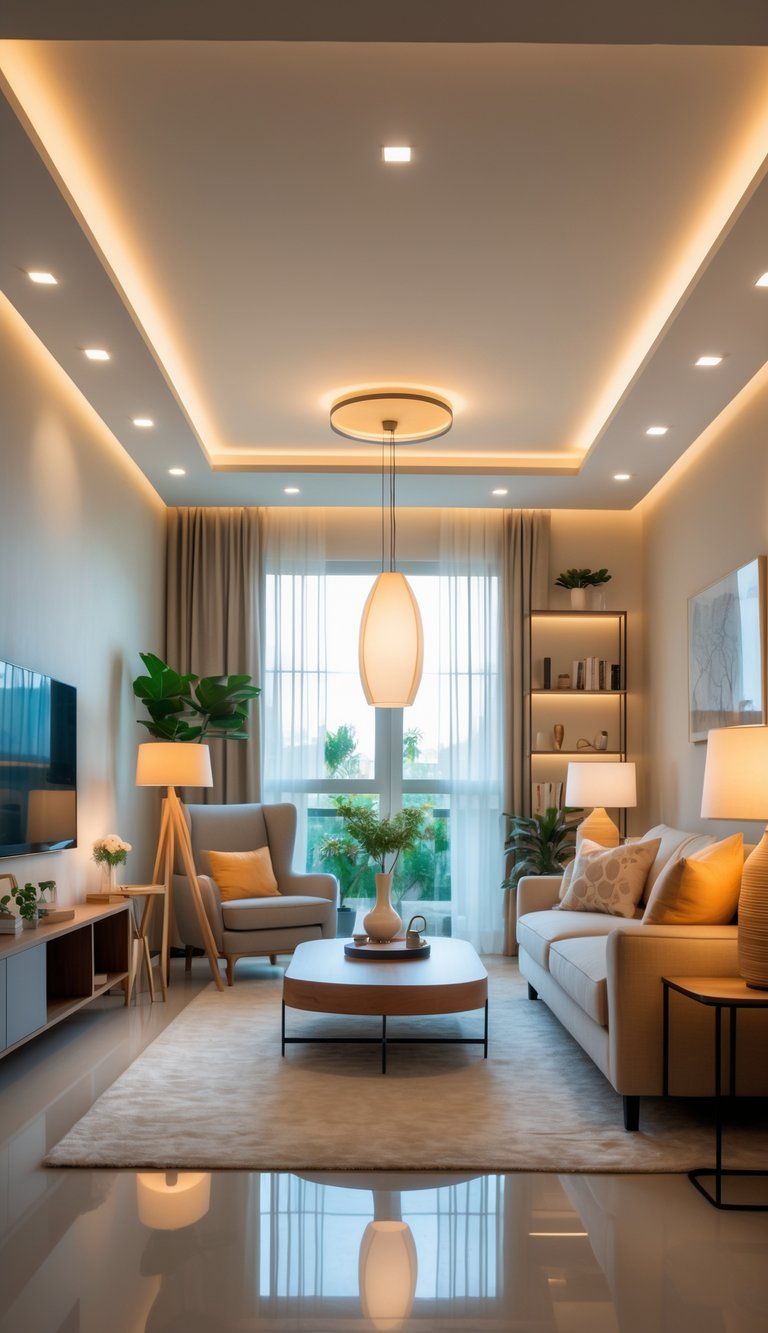
When you create your own lighting plan, you make sure your home feels just right for you. It’s worth putting in a little thought—balancing function and aesthetics makes every space work better and look great.
Assessing Your Lighting Needs
Take a good look at how you actually use each room. Jot down the activities—maybe you read, cook, entertain friends, or just work from home.
Pay attention to how much natural light comes in during the day. If you’ve got a south-facing room, you probably won’t need as much extra lighting as you would in a north-facing one.
Ask yourself who spends the most time in each space. Honestly, older adults usually need a lot more light—sometimes even twice or three times as much as younger folks—to feel comfortable.
Check out where your electrical outlets and switches are. This step’s practical and helps you figure out where you can put lamps or fixtures without tearing up the place.
Key lighting levels to include:
- Ambient (general illumination)
- Task (focused light for specific activities)
- Accent (highlighting features or creating atmosphere)
Integrating Lighting into Your Interior Design
Lighting fixtures really ought to match your décor style, don’t they? If you’re into modern spaces, you might prefer sleek, minimalist fixtures, but if your room feels more traditional, classic chandeliers or sconces just fit.
Popular lighting solutions by style:
- Industrial: Think exposed bulbs and metal finishes.
- Farmhouse: Wooden elements and lantern-inspired styles.
- Contemporary: Clean lines, integrated LEDs—super simple.
- Transitional: Designs that blend styles in a balanced way.
Under-cabinet lights totally change up kitchens. They get rid of those annoying shadows on your work surfaces.
Try installing them about 12-15 inches above your countertops. That’s usually the sweet spot for task lighting.
Table lamps can make living areas feel cozy. Set them at eye level while you’re sitting—usually somewhere between 24 and 27 inches tall—so you won’t get that harsh glare.
Dimmer switches are worth considering. They give you the control to tweak brightness depending on the time of day, your mood, or whatever’s happening in the room.

